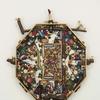AFRICAN AMERICANS: Seeing and Seen, 1766 – 1916
- NEW YORK, New York
- /
- February 15, 2010
Babcock Galleries presents "African Americans: Seeing and Seen, 1766 – 1916," an incisive overview of refined and controversial fine art and popular culture images of African Americans as artists and subjects. Bitter brutality and cruel caricature alternate with respectful revelations and positive portrayals of the status of African Americans. It may be said that all portrayals become betrayals in revealing the motivations and prejudices of their creator, and the images in this exhibition offer telling insights into the prevailing notions of the period. Each work is not only a signpost of the complex nature of our cultural forbearers, but also a harbinger of the ongoing struggle for equal rights in the United States.
Tess Sol Schwab, Assistant Director at Babcock Galleries and curator of this exhibition, points out that African American history “…can be catalogued by the racist and derogatory images across the centuries that have mirrored popular views while at the same time shaping and reinforcing them. Yet, sensitive portrayals of blacks by whites also exist alongside them, as well as inspiring and successful careers by African American artists.” Noting the contradiction in a country’s founding ideal of “all men are created equal” being penned by a man who owned two hundred slaves, "Seeing and Seen" attempts to reveal the many layers that emerged from this complicated beginning.
A portrait of George Washington and his family by Edward Savage omits one name from the caption, the black figure in the corner behind Martha Washington’s red velvet chair (1798). Examples of the “Darktown Comics” series by Thomas Worth present even less flattering caricatures one hundred years later. Compare these to the ambiguous intentions of Eastman Johnson’s soft-toned depiction of a slave yard in "Negro Life at the South" (1859), or Louis Schultze’s shadowy and sympathetic "The Christening" (1800s). Look into the thoughtful eyes of Lucretia Cordelia DeGrasse, a portrait (after 1852) painted by Edward Mitchell Bannister, then look further through Bannister’s eyes in "Doryman" (c. 1880).
Babcock Galleries has been an important and trusted source of American art since 1852. This exhibition re-examines history through compelling source material, to better understand our complex and contradictory cultural heritage, and to raise issues about finally realizing those “certain unalienable Rights” declared at our nation’s birth.
"African Americans: Seeing and Seen, 1766 – 1916" will be on view from January 21 – April 2, 2010. Babcock Galleries is located at 724 Fifth Avenue between 56th and 57th Streets on the 11th Floor. Hours are Monday through Friday, 10am to 5pm, and Saturday by appointment. For more information, and to view the exhibition online, visit www.babcockgalleries.com.
Gallery Contact: Tess Schwab, tschwab@babcockgalleries.com, 212.767.1852
Press Contact: Sarah Donnell, press@babcockgalleries.com, 646.556.5876
BABCOCK GALLERIES
724 Fifth Avenue
New York, NY 10019
(212) 767-1852
fax (212) 767-1857








__2016_100x100_c.jpg)


![Peter Paul Rubens (Flemish, 1577–1640), After Titian (Tiziano Vecelli) (Italian [Venetian], c. 1488–1576), Rape of Europa, 1628–29. Oil on canvas, 71 7/8 x 79 3/8 in. Peter Paul Rubens (Flemish, 1577–1640), After Titian (Tiziano Vecelli) (Italian [Venetian], c. 1488–1576), Rape of Europa, 1628–29. Oil on canvas, 71 7/8 x 79 3/8 in.](/images/c/e2/2e/Jan20_Rape_of_Europa100x100_c.jpg)



